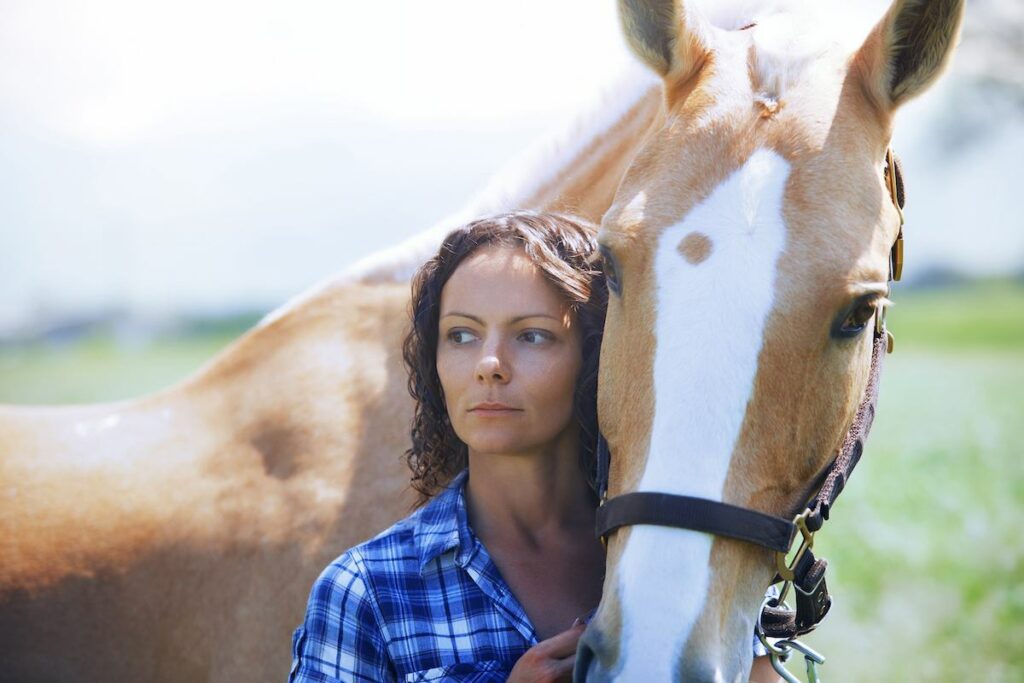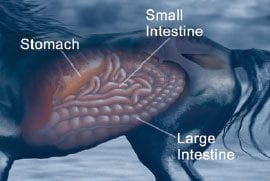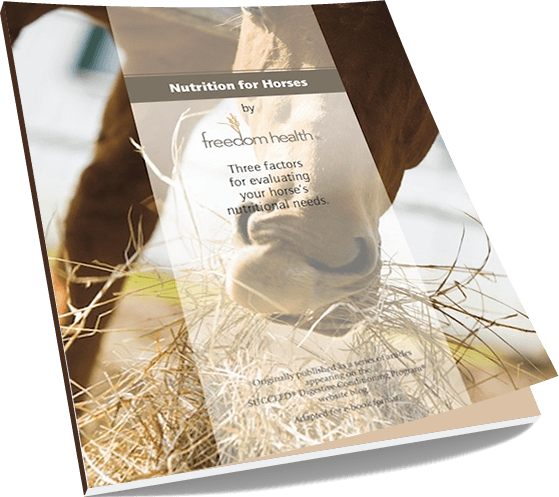by Emma Hardy, PhD published in June/July 2010 issue of The Equine Chronicle.

Through years of riding, showing or training horses, you’re likely to have learned one thing above all else – nothing comes easy.
Many of us got into this equine business and competition because of our love for horses. At one point, didn’t we all have a dream of a pristine and peaceful life with our equine companions? But as time passes and reality sets in, we find ourselves instead continually facing a range of issues, obstacles and challenges.
Rather than doing what we love, we end up working harder than ever to address the demands of clients or trainers, hired help, insurance and more. And the horse itself is not what we imagined. The reality of living and working with horses is that we must continually address issues of health, behavior, attitude, performance ability, and more. We all worry about colic and other serious issues, but even minor health concerns can keep us out of the ring and down for the count.
We also see a slew of issues that we attribute to the horse’s personality or training. Who doesn’t face a touchy or girthy horse at some point? Who among us doesn’t have at least some horses that are nervous, withdrawn, or exhibiting barn vices? How many times do we notice grain in the manure, see a horse off its feed or deal with hard keepers? And how often do we struggle with the horse in training because the horse is simply not willing?
Some of these issues are so common that we lose track, and simply accept them as “the way it is.” But considering how horses today are fed and generally maintained, is all of this really surprising? What if we could do something about these issues, without sacrificing performance and convenience?
It begins with understanding the basics of the horse’s digestive health, what we do to affect this delicate and elaborate system, and how it affects the horse and us.
The Importance of the Hindgut
Gastric ulcers have been in the spotlight in recent years, thanks to well-known treatment and extensive research in this area. As a result, many people associate digestive health with stomach health. But truly understanding the horse’s digestive system means understanding the significance of the hindgut.

This attention on the stomach is ironic, if not downright detrimental. The stomach represents less than 10% of the total volume of the digestive tract. And when you look at the digestive tract in the context of the horse’s frame, you see how small it really is. You also see where it is positioned, high in upper abdomen (under the saddle area), protected by the spine, ribs and other organs, and far from the location of a girth or a rider’s heel.
By contrast, the hindgut is huge and significant to the horse’s digestive process and its health. It is the home of a huge bacterial environment that converts fiber to energy. It may also be the source of so many of the problems we are seeing.
Thanks to extensive research by Franklin L. Pellegrini, DVM, we now know that hindgut ulcers do exist. In fact, they are rather common. Colonic ulcers predominantly affect performance horses, and are frequently identified in horses already suffering from gastric ulcers.
The increase in digestive health issues, in the stomach and in the hindgut, didn’t just happen. These issues evolved as our relationship with the horse evolved, arising from how we feed and care for the animal. In a sense, we have taken horses away from their natural environment and lifestyle, and created the situation we see today.
Yesterday Vs. Today
The natural horse, left to its own devices, will graze on grass (up to 19 hours a day), living in herds in a relatively sedate and low stress lifestyle. In physiological terms, the horse is designed to support this lifestyle. The stomach of the horse is small, and produces gastric acids continuously. The horse chews on grass, introduced to the system a bit at a time, producing saliva which helps buffer the stomach acid. Bacteria and other micro-organisms in the cecum and colon (the hindgut) ferment the consumed fiber in order to digest nutrients from it.
In its natural state this is the primary element of digestion and produces most of the horse’s energy.
Compare this with the lifestyle of the modern horse, particularly performance horses. We have found that the energy produced from grass and other forage alone is not sufficient to meet the energy demands of performance. As a result, we feed the horse a diet which contains quick-releasing, high energy ingredients like grains and commercial feeds. This is often fed on an intermittent basis and often in large amounts. After all, how many of us are able to give our horses several smaller feeds throughout the day?
We also train and show our horses, involving trailering and prolonged stalling. This type of husbandry also means that horses are kept separately, with long periods of inactivity and even solitude, with less access to forage.
Taken together, these various aspects of the modern horse lifestyle begins a chain of events inside the horse which may help to explain many of the health, behavior and performance issues we face every day.
When the Hindgut Goes Wrong
The health of the hindgut is dependent on the delicate balance between beneficial and harmful bacteria, and can be easily altered. Poor digestion of modern grain-based feed causes an increase in the growth of harmful bacteria and a subsequent loss of beneficial bacteria. These events can lead to the production of toxins and can reduce the pH of the hindgut, making it more acidic than it should be. This condition is known as “hindgut acidosis”. This series of events, starting with the feeding of processed feed and leading to the more acidic hindgut, causes even more beneficial bacteria to die, and so the cycle continues. The harmful toxins given off under these circumstances can enter the horse’s bloodstream and cause problems such as starch-induced laminitis and tying up. These toxins can also damage the tissue lining the hindgut, resulting in areas of ulceration.
When the tissue lining the colon is damaged, digestion and absorption are often reduced. This can lead to difficulty gaining or maintaining weight and irritability in the horse. Colic is a further risk, as bleeding colonic ulcers may reduce the blood supply to the end of the small intestine and the hindgut, harming the colon’s ability to effectively move digested feed material along.
The Signs of Trouble
So, if this is going on inside the horse, how can we tell from the outside? There are numerous symptoms of hindgut problems, and not all are obvious. With any digestive disturbance, digestion and absorption will be affected. This will lead to many of the physical signs we might typically associate with the digestive system: loss of weight, poor condition, appetite and performance, diarrhea, and even colic.
Some symptoms associated with poor hindgi tract health may be less obvious. This includes sensitivity on the flanks, reluctance for the horse to flex through the body, extend or collect, and girthyness. Girthyness has long been attributed to stomach issues. But looking at the digestive anatomy, we can see that the location of the stomach is nowhere near the girth. It is the end of the colon which is susceptible to compression on girthing.
Further, any discomfort in the hindgut will likely lead to a poor temperament, lack of focus, and subsequent training issues. After all, how much would you be able to concentrate and work under these conditions?
What Can We Do?
We often find ourselves in a constant cycle – problems occur, we call the veterinarian who diagnoses and treats the condition, and then it all starts over again. How can we manage the horse’s health to address the root causes and avoid these problems in the first place?
The obvious answer is to radically change how we manage, feed, and care for the animal to get closer to the way the horse’s digestive system is naturally designed. This means increasing pasture time and the amount of forage in the diet. Other changes can involve reducing stress and the amount of starch and sugar we feed, especially by adding chaff (chopped hay) to grain meals to activate chewing and substituting fiber such as (soaked) beet pulp for a portion of the grain. However, in many cases this just isn’t practical.
For the most part, we’re stuck with our situation. We want the best for our horses. We want them happy, healthy, willing and WINNING. They need modern feed to ultimately perform and deal with the stress of their highly demanding lives. And it’s unlikely many of us can afford to feed our horses six to eight times a day.
One option is to support a more natural digestive process, and ensure optimal gi tract health, so the horse is more capable of proper digestion in the face of the many challenges described above. Doing this involves providing targeted nutrients to the digestive system. Certain nutrients are shown to enhance the natural structure and function of the digestive tract, and allow the horse to mend itself under these conditions. Examples include beta glucan, nucleotides, polar lipids, certain amino acids and mannan oligosaccharides (MOS).
Beta glucan is a soluble fiber that is known to be a powerful natural stimulant to the immune system. Nucleotides are components of DNA, which are essential for cell reproduction and tissue development. Polar lipids are components of oil from certain vegetables which provide a natural protective barrier for tissue, and which have been shown to increase absorption of fat-soluble vitamins (A, K, D and E). And MOS is known to bind pathogens, including bacteria and mycotoxins, allowing them to be excreted in the horse’s waste.
Daily supplementation with products containing these nutrients can help maintain a healthy digestive system, which may reduce the various health and performance issues we deal with. Always consult with your veterinarian when changing your horse’s diet and introducing a new supplement program. More and more veterinarians today are introducing wellness programs into their practices, and are open to the value of diet and supplementation as part of the animal’s daily care.
Better Inside, Better Outside
Isn’t it better to keep your horse healthy and enjoying life and enjoying you? With a healthy horse, we get a happier horse – a friend yet a superb athlete that is ready and willing to perform. Isn’t it much cheaper in the long run (maybe even short-term), to have your horse always ready to perform, maybe consuming much less bagged feed while keeping on weight, perhaps avoiding the veterinary expenses when the digestive tract goes wrong?
Then, you have the real horse shine through: calm and focused when you want it, yet ready to achieve its athletic potential whenever you ask for it. Then perhaps you can focus on what is important to you, instead of spending so much time, energy and money on all of these issues.

FREE eBook:
Nutrition for Horses
Three factors for evaluating
your horse’s nutritional needs.
